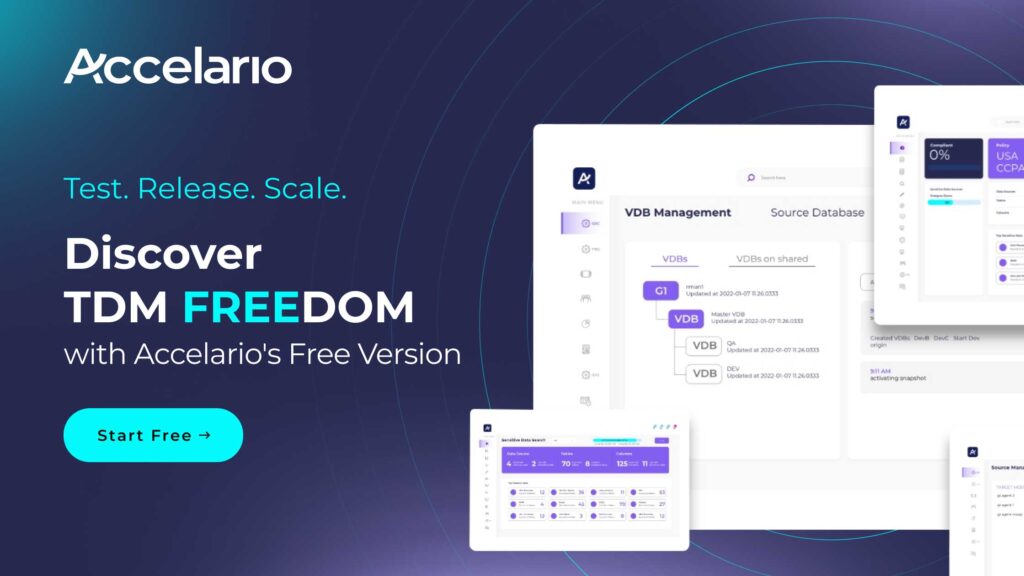Table of Contents Hide
Database Virtualization Explained: Benefits, Use Cases, and Best Practices
 9 MIN. READING
9 MIN. READING
Database Virtualization: A Comprehensive Guide to Virtual Databases
Database virtualization is a cutting-edge technology that is transforming the way businesses manage and utilize their data. By creating a virtual database layer, organizations can achieve greater flexibility, efficiency, and cost savings. In this comprehensive guide, we will delve into the concept of database virtualization, its advantages and disadvantages, and how Accelario’s innovative solutions can help your business harness the power of this technology.
What is Database Virtualization?
Database virtualization is the process of abstracting the database layer from the underlying physical infrastructure. This means that multiple virtual databases can be created from a single physical database, enabling users to access and manipulate data without needing to know where or how the data is stored.
By separating the logical view of the data from the physical storage, database virtualization allows for greater flexibility and efficiency in data management. For a more detailed explanation, check out our database virtualization glossary.
The Mechanics of Database Virtualization
Database virtualization involves creating a virtual layer that sits between the physical database and the applications that use the data. This virtual layer allows multiple applications to access the same physical database as if they were separate entities. This separation provides numerous benefits, including:
- Scalability: Virtual databases can be easily scaled to meet the growing needs of an organization.
- Resource Optimization: By abstracting the physical resources, database virtualization allows for better utilization of hardware and software resources.
- Enhanced Security: Virtual databases can be isolated from each other, providing an additional layer of security.
What is a Virtual Database?
A virtual database is an instance created within the virtual layer. It appears to users and applications as a fully functional database, but it is actually a subset or a copy of the data from the physical database. Virtual databases provide several benefits:
- Cost Efficiency: Reduces the need for physical hardware and associated maintenance costs.
- Flexibility: Allows for rapid deployment and configuration of databases.
- Improved Testing and Development: Developers can create multiple virtual databases for testing and development purposes without impacting the production environment.
Database Virtualization Advantages and Disadvantages
Like any technology, database virtualization comes with its own set of advantages and disadvantages. Understanding these can help you make an informed decision about whether this approach is right for your organization.
Advantages
Simplified Data Management
Managing multiple databases can be complex and time-consuming. Database virtualization simplifies this by providing a single access point, reducing the need for specialized database administrators for each system.
Cost Efficiency
Virtualization reduces the need for physical hardware and storage, leading to significant cost savings. Organizations can maximize their existing resources without investing in additional infrastructure.
Enhanced Performance
By consolidating databases virtually, organizations can improve data retrieval times and overall performance. The virtualization layer optimizes queries, ensuring faster access to data.
Scalability
Virtual databases can be easily scaled up or down based on demand. This flexibility ensures that organizations can handle varying workloads without disruption.
Improved Disaster Recovery
With database virtualization, data is not tied to specific hardware, making it easier to implement robust disaster recovery plans. Data can be replicated across multiple locations, ensuring high availability.
Disadvantages
Complexity
Implementing and managing a virtualized database environment can be complex. It requires a thorough understanding of both the virtual and physical database architectures.
Security Concerns
Consolidating databases virtually can create security risks if not managed properly. Ensuring robust security measures are in place is crucial to protect sensitive data.
Use Cases for Database Virtualization
Database virtualization can be applied in various scenarios to address specific business needs. Here are some common use cases:
Development and Testing
Developers often need access to production-like environments for testing purposes. Creating physical copies of production databases can be time-consuming and costly. Virtual databases allow developers to quickly create multiple instances of the production database, enabling efficient testing and development without impacting the live environment.
Data Integration
Organizations often need to integrate data from multiple sources. Database virtualization simplifies data integration by providing a unified view of data from different sources. This enables more efficient data analysis and reporting.
Disaster Recovery
Database virtualization enhances disaster recovery capabilities by allowing for quick and efficient backups and restores. Virtual databases can be easily replicated and restored in the event of a failure, minimizing downtime and data loss.
Data Migration
Migrating data from one database to another can be a complex and risky process. Database virtualization simplifies data migration by allowing organizations to create virtual copies of the data in the target environment. This enables seamless data migration with minimal disruption to the business.
Best Practices for Database Virtualization
To maximize the benefits of database virtualization, it is important to follow best practices. Here are some key considerations:
1. Assess Your Needs
Before implementing database virtualization, it is crucial to assess your organization’s needs and objectives. Understand the specific challenges you aim to address and define clear goals for the virtualization initiative.
If you’re needing some assistance with choosing a database virtualization vendor, check out our Test Data Management Vendor Checklist.
2. Choose the Right Solution
Select a database virtualization solution that aligns with your organization’s requirements. Consider factors such as scalability, security, ease of use, and compatibility with your existing infrastructure.
3. Plan for Performance
While database virtualization offers many benefits, it can also introduce performance overhead. Plan your virtualization strategy to minimize any potential impact on data access speed and ensure optimal performance.
4. Implement Security Measures
Security is a critical consideration in any database environment. Implement robust security measures, such as data masking, encryption, and access controls, to protect sensitive data in your virtualized databases.
5. Monitor and Optimize
Continuous monitoring and optimization are essential to ensure the ongoing efficiency and effectiveness of your virtualized database environment. Regularly review performance metrics, identify areas for improvement, and make necessary adjustments.
Accelario’s Database Virtualization Solutions
Accelario offers a range of database virtualization solutions designed to help organizations achieve greater flexibility, efficiency, and cost savings. Our solutions are built on advanced technology and are designed to meet the unique needs of modern businesses.
Seamless Data Access
Accelario’s platform provides seamless access to data across multiple databases, simplifying data management and improving efficiency.
AI Data Anonymization
To address security concerns, we offer advanced AI data anonymization features. Sensitive data is protected through robust masking techniques, ensuring compliance with data protection regulations.
Optimized Performance
Our platform is designed to optimize performance, even in high-transaction environments. By intelligently managing the virtualization layer, we ensure minimal performance overhead.
Scalable Solutions
Accelario’s platform is highly scalable, accommodating the needs of growing organizations. Whether you need to scale up for increased demand or scale down during off-peak times, our solution provides the flexibility you need.
Robust Disaster Recovery
We prioritize data availability and disaster recovery. Our platform includes features for data replication and backup, ensuring your data is always accessible, even in the event of human errors or bugs.
Implementing Database Virtualization with Accelario
Implementing database virtualization with Accelario is a straightforward process. Here are the key steps:
- Assessment: We start by assessing your current database environment and identifying opportunities for virtualization.
- Planning: Our team works with you to develop a customized database virtualization strategy that meets your specific needs.
- Implementation: We implement the database virtualization solution, including the creation of virtual databases and the configuration of automated provisioning tools.
- Training: We provide training and support to ensure your team is fully equipped to manage the virtualized database environment.
- Ongoing Support: Our team provides ongoing support to ensure your database virtualization environment continues to operate efficiently and effectively.
Try Accelario for Free Today

Experience the power of database virtualization with Accelario’s free Test Data Management platform. Our free version provides essential test data management features, enabling you to create virtual copies of your databases for testing without affecting production environments. This free version is ideal for organizations of all sizes to explore robust virtualization techniques, ensuring efficient resource utilization and reducing the risk of data errors. You can start today and discover how Accelario can transform your data management and operational efficiency practices.
Ready to experience free TDM? Start using Accelario for free today.
To learn more details about the Accelario Free Version, read our blog.
Database Virtualization in the Future
The future of database virtualization looks promising. As more organizations recognize the benefits of this technology, its adoption is expected to grow. Here are some future trends to watch:
Enhanced Security Features
With increasing concerns about data privacy and security, future database virtualization solutions are likely to incorporate enhanced security features, such as advanced encryption, multi-factor authentication, and real-time threat detection.
AI and Machine Learning
Artificial intelligence (AI) and machine learning are expected to play a significant role in the future of database virtualization. These technologies can be used to optimize database performance, automate management tasks, and improve data analytics capabilities.
Greater Adoption Across Industries
As more organizations recognize the benefits of database virtualization, adoption is expected to increase across various industries, including finance, healthcare, retail, and manufacturing.
Conclusion
Database virtualization is a powerful technology that offers numerous benefits, including cost savings, increased efficiency, and enhanced flexibility. By leveraging Accelario’s advanced database virtualization solutions, organizations can optimize their data management processes and achieve greater business success. Whether you are looking to improve your development and testing environment, enhance disaster recovery capabilities, or streamline data integration, database virtualization can help you achieve your goals.
For more information on how Accelario can help you implement database virtualization, contact us today.


